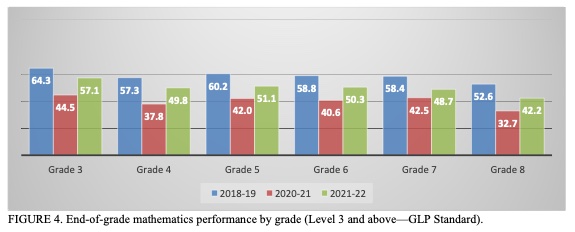Today, state education officials released 2021-22 testing results and graduation rates for all North Carolina public schools.
Scores from the 2020-21 school year were sobering. The North Carolina Department of Public Instruction’s Office of Learning Recovery and Acceleration used state test score data to assess the statewide academic impact of the loss of instructional time. Researchers concluded that the effect was negative “for all students, for all grades, for almost every subject (except English II).”
As students returned to school in 2021, the conventional wisdom was that the new school year offered fewer impediments to learning. As a result, statewide performance rebound during the 2021-22 school year, although proficiency rates are not back to pre-lockdown levels.
Across the elementary and middle school grades, grade-level proficiency in reading and math increased compared to the 2020-21 scores (see figures below). Fifth- and eighth-grade science proficiency also rose. Public schools saw gains in both high school math and biology. The only exception was the 0.6 percentage point drop in English II.

Annual Testing Reports” (September 1, 2022)

Annual Testing Reports” (September 1, 2022)
State agency leaders also published test score growth results. The percentage of schools that did not meet their growth expectations increased compared to 2018-19. Overall, 30.4% of schools did not meet growth last year, while 26.7% failed to do so in 2019. On a positive note, the percentage of schools that exceeded expected growth rose from 27.9% in 2019 to 28.8% in 2022. The remaining schools met expected growth.
Of course, statewide scores obscure variations in performance across districts, schools, grades, and student subgroups. For example, math and reading proficiency rates in Halifax County were appalling. In 2021, the district spent an average of nearly $14,700 per student. Yet only 17.2% of elementary and middle school students were proficient in math, and 22.9% of students in those grades were proficient in reading last year. Asheville City spent nearly $14,300 per student, yet proficiency rates for black students were shockingly low in 2022. The highest proficiency rate for this subgroup was 26% in English II.
Without a doubt, credit goes to classroom educators who prioritized raising student performance amidst pressure by teacher unions and advocacy organizations to discount the importance of test scores and other quantitative measures of academic performance. I also credit Superintendent Truitt and state education leaders for their unwavering focus on academic achievement as schools start the long-term process of recovering from pandemic-era lockdowns.


